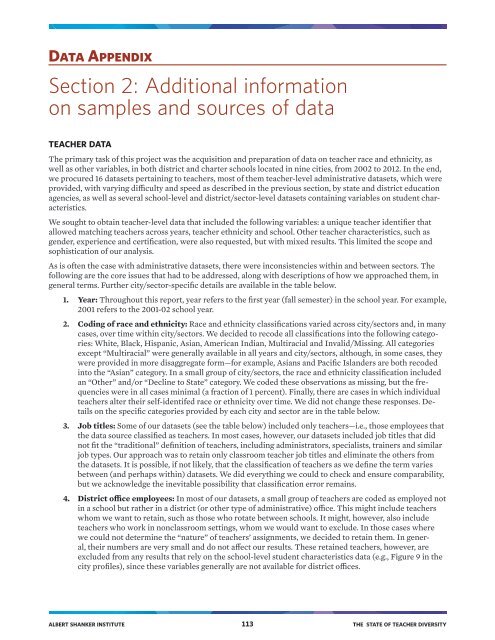TEACHER DIVERSITY
The State of Teacher Diversity_0
The State of Teacher Diversity_0
- No tags were found...
Create successful ePaper yourself
Turn your PDF publications into a flip-book with our unique Google optimized e-Paper software.
Data Appendix<br />
Section 2: Additional information<br />
on samples and sources of data<br />
<strong>TEACHER</strong> DATA<br />
The primary task of this project was the acquisition and preparation of data on teacher race and ethnicity, as<br />
well as other variables, in both district and charter schools located in nine cities, from 2002 to 2012. In the end,<br />
we procured 16 datasets pertaining to teachers, most of them teacher-level administrative datasets, which were<br />
provided, with varying difficulty and speed as described in the previous section, by state and district education<br />
agencies, as well as several school-level and district/sector-level datasets containing variables on student characteristics.<br />
We sought to obtain teacher-level data that included the following variables: a unique teacher identifier that<br />
allowed matching teachers across years, teacher ethnicity and school. Other teacher characteristics, such as<br />
gender, experience and certification, were also requested, but with mixed results. This limited the scope and<br />
sophistication of our analysis.<br />
As is often the case with administrative datasets, there were inconsistencies within and between sectors. The<br />
following are the core issues that had to be addressed, along with descriptions of how we approached them, in<br />
general terms. Further city/sector-specific details are available in the table below.<br />
1. Year: Throughout this report, year refers to the first year (fall semester) in the school year. For example,<br />
2001 refers to the 2001-02 school year.<br />
2. Coding of race and ethnicity: Race and ethnicity classifications varied across city/sectors and, in many<br />
cases, over time within city/sectors. We decided to recode all classifications into the following categories:<br />
White, Black, Hispanic, Asian, American Indian, Multiracial and Invalid/Missing. All categories<br />
except “Multiracial” were generally available in all years and city/sectors, although, in some cases, they<br />
were provided in more disaggregate form—for example, Asians and Pacific Islanders are both recoded<br />
into the “Asian” category. In a small group of city/sectors, the race and ethnicity classification included<br />
an “Other” and/or “Decline to State” category. We coded these observations as missing, but the frequencies<br />
were in all cases minimal (a fraction of 1 percent). Finally, there are cases in which individual<br />
teachers alter their self-identifed race or ethnicity over time. We did not change these responses. Details<br />
on the specific categories provided by each city and sector are in the table below.<br />
3. Job titles: Some of our datasets (see the table below) included only teachers—i.e., those employees that<br />
the data source classified as teachers. In most cases, however, our datasets included job titles that did<br />
not fit the “traditional” definition of teachers, including administrators, specialists, trainers and similar<br />
job types. Our approach was to retain only classroom teacher job titles and eliminate the others from<br />
the datasets. It is possible, if not likely, that the classification of teachers as we define the term varies<br />
between (and perhaps within) datasets. We did everything we could to check and ensure comparability,<br />
but we acknowledge the inevitable possibility that classification error remains.<br />
4. District office employees: In most of our datasets, a small group of teachers are coded as employed not<br />
in a school but rather in a district (or other type of administrative) office. This might include teachers<br />
whom we want to retain, such as those who rotate between schools. It might, however, also include<br />
teachers who work in nonclassroom settings, whom we would want to exclude. In those cases where<br />
we could not determine the “nature” of teachers’ assignments, we decided to retain them. In general,<br />
their numbers are very small and do not affect our results. These retained teachers, however, are<br />
excluded from any results that rely on the school-level student characteristics data (e.g., Figure 9 in the<br />
city profiles), since these variables generally are not available for district offices.<br />
ALBERT SHANKER INSTITUTE 113 THE STATE OF <strong>TEACHER</strong> <strong>DIVERSITY</strong>


